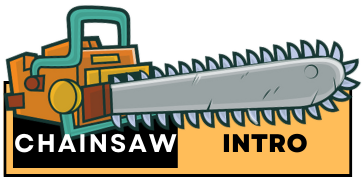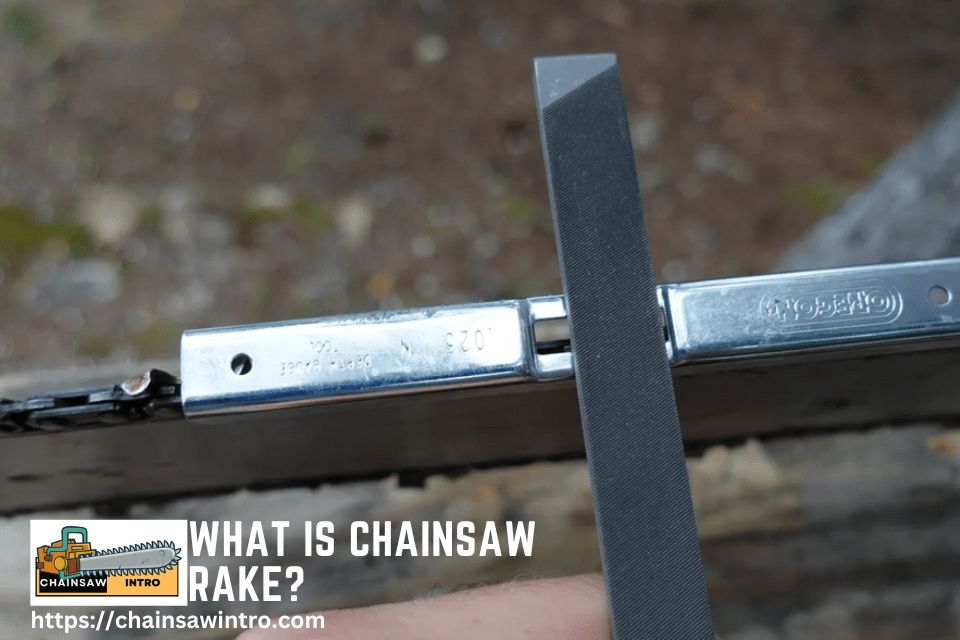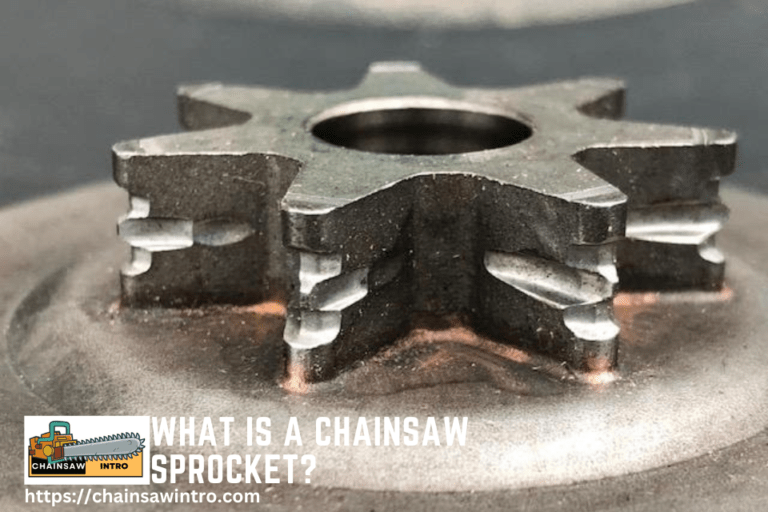When it comes to chainsaw performance, most people focus on the sharpness of the chain or the power of the engine. But there’s another critical factor that directly affects how efficiently your chainsaw cuts: the rake angle (also called the depth gauge setting). If you’ve ever wondered, “What is the rake on a chainsaw?” this guide will explain everything you need to know—from what it is, how it works, and why it matters for safe and efficient cutting.
Chainsaw Sharpening, filing Rakers, tips, and tricks.
Understanding the Rake on a Chainsaw
The rake on a chainsaw refers to the depth gauge or raker—a small metal protrusion in front of each cutting tooth on the chain. Its primary job is to control how deep the cutting tooth bites into the wood.
- If the rake is set too high, the cutting tooth won’t take much wood, resulting in slow, inefficient cutting.
- If the rake is set too low, the cutter will take too much wood at once, causing the saw to grab, jerk, or stall, which can be dangerous.
In simple terms, the rake acts like a safety and efficiency regulator for your chainsaw chain.
Why Is the Rake Important?
The rake directly influences a chainsaw’s performance and safety:
- Cutting Efficiency: A properly set rake allows the cutter to remove consistent wood chips, optimizing speed and reducing effort. If the rake is too high, the saw cuts slowly, producing fine dust instead of chips, per Oregon’s 2025 manuals.
- Safety: A rake set too low increases the chain’s aggressiveness, raising the risk of kickback, which causes over 30% of chainsaw injuries, according to the CDC. A well-maintained rake ensures smoother, safer operation.
- Engine/Motor Longevity: Incorrect rake settings force the saw to work harder, leading to overheating or premature wear in gas-powered models (e.g., Husqvarna 455 Rancher) or battery drain in cordless saws (e.g., Ego CS2005), per Consumer Reports.
- Versatility: Adjusting the rake height allows users to customize the chain for specific tasks, like aggressive cutting for hardwood or smoother cuts for softwood, as discussed on Reddit’s r/Chainsaw.
Proper rake maintenance is essential for any chainsaw, whether it’s a gas-powered Stihl MS 271 or a battery-powered Greenworks 40V.
How the Rake Works in a Chainsaw Chain? Standard Rake Setting
A chainsaw chain consists of cutter teeth, rakes, and drive links, all working together to cut wood. The cutter tooth does the actual slicing, while the rake regulates how deep the cutter digs into the wood. The height difference between the rake and the cutter’s top plate, known as the depth gauge setting, determines the size of the wood chip removed. For example:
- Standard Setting (0.025-0.030 inches): Ideal for general-purpose cutting, balancing speed and safety for homeowners, per 2025 Popular Mechanics.
- Lower Setting (0.015-0.020 inches): Used for aggressive cutting in hardwoods like oak, but increases kickback risk, per ArboristSite.
- Higher Setting (0.035 inches): Suits softwoods like pine, reducing strain but slowing cuts.
The rake’s shape and height vary by chain type (e.g., 3/8” or .325” pitch), and manufacturers like Oregon and Stihl provide specific guidelines for each chain model.

How to Check and Adjust the Rake?
Maintaining the correct rake height is critical, especially after sharpening the cutter teeth, which reduces their height and alters the depth gauge setting. Here’s how to check and adjust the rake, based on 2025 Oregon guides and YouTube tutorials:
- Inspect the Rake: After sharpening the chain (every 2-3 hours of use), check the rake height using a depth gauge tool ($5-$10 at Home Depot). Place the tool over the chain; the rake should sit just below the tool’s slot.
- File the Rake: If the rake is too high (protruding above the tool), use a flat file (e.g., Stihl’s 2-in-1 file holder, $20-$30) to lower it. File gently in one direction, maintaining the rake’s curved shape, and check frequently to avoid over-filing.
- Verify the Setting: Ensure the rake is 0.025-0.030 inches below the cutter for standard chains, or consult the chain’s manual for specific settings.
- Test the Chain: After adjustment, test-cut a small log. The saw should produce coarse wood chips, not dust, indicating proper rake height, per FireAndSaw.com.
Professionals on ArboristSite recommend checking the rake every 2-3 sharpening sessions, as filing the cutters gradually raises the relative height of the depth gauges.
Factors Affecting Rake Performance
Several factors influence how the rake performs and when it needs adjustment:
- Sharpening Frequency: Frequent sharpening (e.g., every 2-3 hours) reduces cutter height, requiring rake adjustments to maintain the correct depth, per our article on chainsaw files.
- Wood Type: Hardwoods wear cutters faster, necessitating more frequent rake checks compared to softwoods, per Reddit discussions.
- Chain Type: Low-kickback chains (ANSI B175.1-compliant) have higher rakes for safety, while professional chains may have lower settings for speed, per Stihl’s 2025 manuals.
- User Technique: Aggressive cutting or improper angles during sharpening can damage rakes, reducing efficiency and safety.
- Chain Wear: Worn or damaged rakes (e.g., bent or chipped) require replacement chains ($20-$50), as they cannot be repaired.
Tools for Maintaining the Rake
To maintain the rake effectively, invest in these tools, recommended by 2025 Home Depot reviews:
- Depth Gauge Tool: Ensures accurate rake height (e.g., Oregon 27742, $5-$10).
- Flat File: Used to file down rakes (e.g., Stihl flat file, $2-$5).
- File Guide: Combines round and flat filing for cutters and rakes (e.g., Stihl 2-in-1, $20-$30).
- Chain Vise: Secures the chain during maintenance ($10-$20).
These tools are affordable and essential for keeping the rake and chain in top condition.
Safety Considerations with the Rake
An improperly set rake can increase kickback risks, leading to severe injuries, with over 30,000 chainsaw-related emergency room visits annually, per the CDC. A rake set too low makes the chain overly aggressive, while a rake too high reduces cutting efficiency, straining the saw and user. Always wear PPE (chainsaw chaps, helmet, gloves, safety glasses, steel-toe boots) and ensure the chain brake is functional, per OSHA 2025 guidelines. Test the chain after rake adjustments to confirm smooth, safe cutting, and avoid cutting above shoulder height, as discussed in our article on chainsaw dangers.
Rake Settings for Different Chainsaw Types
Rake settings vary slightly by chainsaw and chain type:
- Gas-Powered Chainsaws (e.g., Echo CS-590, Husqvarna 455 Rancher): Typically use 0.025-inch settings for 3/8” pitch chains, balancing power and safety for firewood or tree felling.
- Battery-Powered Chainsaws (e.g., Greenworks 80V, Ego CS2005): Often use low-kickback chains with 0.030-inch rakes for safer operation, per Consumer Reports.
- Corded Electric Chainsaws (e.g., Oregon CS1500): Similar to battery saws, prioritizing safety with higher rake settings for homeowner tasks.
Check the manufacturer’s manual for exact specifications, as brands like Oregon or Stihl may recommend slight variations.
Conclusion
The rake, or depth gauge, is a vital component of a chainsaw chain, controlling cutting depth to ensure efficiency, safety, and engine longevity. Typically set 0.025-0.030 inches below the cutter, the rake prevents excessive biting, reducing kickback risks and strain. Regular maintenance—checking and filing the rake every 2-3 sharpening sessions—keeps your chainsaw performing optimally, whether it’s a gas-powered Stihl or a battery-powered Greenworks. Use a depth gauge tool and flat file to maintain the correct height, and always prioritize safety with proper PPE and technique. By understanding and managing the rake, you’ll achieve smoother, safer cuts and extend your chainsaw’s life. Ready to sharpen your skills?
Frequently Asked Questions
What happens if rakers are too low?
If the rakers (depth gauges) are filed too low, the cutting teeth will remove too much wood at once. This makes the chainsaw aggressive, harder to control, and more prone to kickback, which is dangerous for the user.
What happens if rakers are too high?
If the rakers are too high, the cutting teeth will take very little wood with each pass. This results in slow cutting, fine sawdust instead of chips, and extra strain on the chainsaw engine.
Do I need to file rakers every time I sharpen my chain?
Not always. Rakers should be checked after every 2–3 chain sharpenings. If the cutters are filed down significantly, the rakers may need to be lowered slightly to maintain the proper depth setting.
How do I measure rake depth?
The best way to measure rake depth is with a chainsaw depth gauge tool. Place the tool over the chain; if the raker protrudes above the slot, it needs to be filed down with a flat file.
What is the standard rake setting for chainsaws?
Most chainsaws perform best with a rake depth of 0.025 inches (0.63 mm). However, this can vary depending on the type of wood and the manufacturer’s recommendations.
Can adjusting rakers improve cutting speed?
Yes. Properly set rakers balance cutting speed and safety. Lower rakers slightly can make the saw cut faster in hardwood, but it should only be done by experienced users who understand the increased risk of kickback.
William C. Bozeman is a seasoned chainsaw expert and outdoor power tool enthusiast with over a decade of hands-on experience in tree cutting, forestry, and property maintenance. Having worked with leading chainsaw brands like Stihl, Husqvarna, and Oregon, Bozeman shares practical knowledge, safety tips, and honest reviews to help homeowners, DIYers, and professionals make informed decisions.



